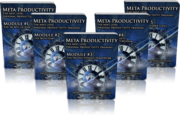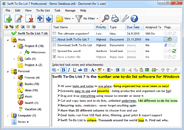Guest post by Brian J. Willett
Acknowledging that you need help can be a difficult thing. But rather than wait for some sort of efficiency intervention, it’s always best to come to the conclusion yourself when it pertains to your productivity. Although the realization that you need to enhance your efficiency and better organize your workflow won’t instantly improve your results, it can act as a definite indication that you need to adopt GTD practices. Taking simple steps within the large realm of GTD practices – such as changing your perspective and taking control — can put you on the path toward increased efficiency and improved work performance. So how do you make this determination? Many telltale signs of the need for GTD exist, but here are a few that stand out in our minds.
Top 5 Reasons You Need to GTD
- You’re reading this article
- You’re falling behind
- You have trouble “getting motivated”
- You’re not sure if you’re productive
- You’re overwhelmed by stuff
You’re Reading This Article
Knowledge is power. But power doesn’t equal results, so you’re going to have to move from awareness of the issue – which is commendable, as ignorance is anything but bliss in the workplace – to action on the issue. So if you’re reading an article to help you decide whether GTD is relevant to your interests, great. But that’s not going to make you more productive. In fact, investigating the issue without acting can be what I call a ‘procrastination proxy.’ That is, instead of just being full-out unproductive, you’re putting off tasks that are seemingly beneficial but are still keeping you from the tasks you need to accomplish. Sometimes, your needs have to come before your interests. Reading about GTD may ease your conscience, but it doesn’t address your productivity problems; it’s a proxy for procrastination.
When I work from home, sometimes I feel an incredible urge to clean the kitchen or read up on a topic somewhat related to my work. And while these activities can be described as productive, they don’t help put words on paper, which tends to be my primary goal. When you are seeking out information related to GTD, be sure you’re not just a passive spectator, but are instead consuming the information with the intent to utilize it – be sure your activities are productivity partners, not procrastination proxies.
You’re Falling Behind
No one likes to be behind on work (or play, for that matter), but it’s better to reach the conclusion than to be told about it. If your to-do list grows by the day and tasks keep getting pushed from one day to the next, chances are you’re not keeping up. That’s why Swift To-Do List is so advantageous – it provides a clear, easy-to-understand list of your tasks so you can see individual items that need work and an overall view of the big picture. Swift To-Do List 7 lets you prioritize items and provides customized reminders of your choosing to keep you on task. A personalized, prioritized task list with deadlines makes you accountable and can prevent you from falling behind.
You’re Having Trouble “Getting Motivated”
There are many reasons why you don’t feel motivated to complete work. Stress, lethargy and a lack of interest are possibilities, but a common cause is not knowing where to start. A big part of GTD is gaining perspective; thus, getting your goals and tasks on paper is essential. Visualizing the work you need to complete, in the order you need to complete it, provides a framework for productivity and an impetus to get started because your goals are clear and attainable.
Using Swift To-Do List 7 can get you motivated with on-screen reminders, e-mails, printed task lists and settings for types and priorities of list items. Thus, you won’t just know where to start but you’ll want to start. The ability to attach files and maintain notes on each list item can also help you get over the anxiety of getting to work because you’ll already have some work done to get you off on the right foot.
You’re Not Sure If You’re Productive
At this point, you may be wondering if GTD is really for you. If you’re not consistently behind on tasks or receiving warnings from superiors, you may feel as though you’re productive enough. But could you be more efficient? Honestly, we all could.
One way to tell is to time your tasks. Swift To-Do List provides a timer so you can see how long your work takes you; this allows you to track your performance and see if there is a trend – perhaps you work quicker in the morning or on Tuesdays or after having pancakes for breakfast. Whatever the circumstances, a timer allows you to take notice and take control.
But a less common, though equally advantageous, use of the timer is timing how long you are not on task. Create a task “not working” and time track it every time you surf over to Facebook or start shoe shopping. This will show you just how long you are at work but not working; the results can be astonishing. Tracking this downtime can help you avoid being unproductive in the future by making you cognizant of the time you’re wasting and by making you re-think what you’re about to do; the act of starting and stopping the timer is a reminder that you’re not being as productive as you could be. Save the aimless surfing for your lunch break or you might find yourself permanently on break.
You’re Overwhelmed By “Stuff”
In the workplace, “stuff” can loosely be defined as all of the things standing in the way of you and your work. Whether it’s remembering to grab ice cream on the way home from work or filling out an office survey, having a lot of stuff floating around is never beneficial for productivity. GTD can help you cut through the stuff, if you have the right tools. Stuff tends to be most distracting when it’s floating around your head, so putting your stuff on paper to keep track of it can help you move through it. But still, the stuff remains. What is truly useful is a tool like Swift To-Do List 7’s filters – these allow you to choose what stuff you see, based on due dates, status, start date, priority or task type. This makes your stuff more manageable and keeps you from seeing your stuff until it’s absolutely necessary to do so.
Make your stuff work for you – prioritize appropriately by using lists and sublists (the colored icons can serve as great mental reminders) and your stuff won’t seem so imposing any more.





